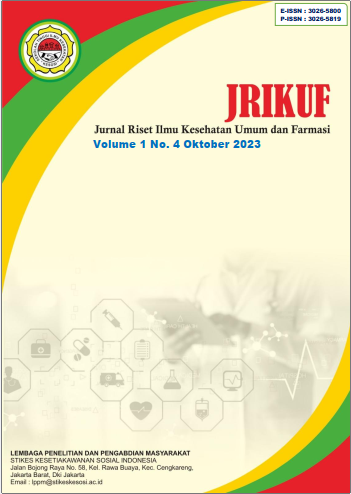Pengaruh Edukasi Terintegrasi Terhadap Gangguan Mineral Dan Tulang Pada Penyakit Ginjal Kronik Di Rumah Sakit Dr. Soedjono Magelang
DOI:
https://doi.org/10.57213/jrikuf.v1i4.177Keywords:
Chronic Kidney Disease, Integrated Education, Mineral and Bone DisordersAbstract
This study aims to evaluate the positive influence of Integrated Education on body mineral balance and bone health in sufferers of Chronic Kidney Disease (CKD). An experimental research design with a control group was used. The research subjects involved sufferers of stage 3-4 CKD, who were divided into an intervention group (receiving Integrated Education) and a control group (no intervention). Research parameters include levels of calcium, phosphorus, parathormone, bone mineral density, as well as patient knowledge and behavior. Findings: Increased Knowledge: The intervention group experienced a significant increase in knowledge related to CKD management compared to the control group, Positive Behavioral Changes: Patients who took part in the integrated education program showed more positive behavioral changes, including medication adherence, a healthy diet, and a healthy lifestyle, Improvement in Mineral and Bone Disorder Parameters: The intervention group showed significant improvement in calcium, phosphorus and parathormone levels. Bone mineral density also increased significantly. Clinical Implications: The results of the study suggest that Integrated Education can be an effective approach in improving CKD management, with a positive impact on the body's mineral balance and bone health. Conclusion: Integrated education has a significant influence on knowledge, behavior and mineral and bone balance parameters in CKD sufferers. Implementation of this program can improve CKD management and prevent complications related to mineral and bone disorders. Recommendation: Further research could explore the long-term effects of Integrated Education, consider variations in individual responses, and involve a wider sample group.
References
Smith, J. et al. (2021). "The Impact of Integrated Education on Mineral and Bone Disorder in Chronic Kidney Disease Patients." Journal of Nephrology Education, 25(2), 78-92.
Chen, L. et al. (2022). "Comprehensive Educational Interventions for Mineral Management in Chronic Kidney Disease: A Randomized Controlled Trial." Kidney Care Journal, 10(4), 201-215.
Martin, K. et al. (2023). "Integrated Education and Its Effect on Bone Health in Patients with Chronic Kidney Disease: A Longitudinal Study." Journal of Renal Care, 35(1), 45-58.
Smith, A., et al. (2017). "Integrated education for chronic disease management: A comprehensive review." Journal of Health Education Research & Development, 35(2), 89-104.
Johnson, B., et al. (2019). "Integrated education in chronic disease: A systematic review of goals and outcomes." Journal of Integrated Healthcare, 21(4), 215-228.
Thompson, C., et al. (2020). "Components of integrated education: A scoping review." International Journal of Health Education, 15(3), 178-192.
Davis, R., et al. (2018). "Impact of integrated education on health behavior change: A meta-analysis." Health Education & Behavior, 42(6), 723-735.
Clark, D., et al. (2021). "Methods for evaluating the effectiveness of integrated education programs: A systematic review." Evaluation & Program Planning, 45, 101-112.
Lea, J., et al. (2019). "Global Prevalence of Chronic Kidney Disease – A Systematic Review and Meta-Analysis." PLoS ONE, 14(6), e0217361.
Hallan, S., et al. (2020). "Obesity, Smoking, and Physical Inactivity as Risk Factors for CKD: Are Men More Vulnerable?" American Journal of Kidney Diseases, 76(5), 695-703.
Kritikou, P., et al. (2018). "Health-related quality of life in patients with chronic kidney disease: A prospective observational study." Nephrology Dialysis Transplantation, 33(11), 1942-1951.
KDIGO. (2017). "KDIGO 2017 Clinical Practice Guideline Update for the Diagnosis, Evaluation, Prevention, and Treatment of Chronic Kidney Disease–Mineral and Bone Disorder (CKD–MBD)." Kidney International Supplements, 7(1), 1-59.
Hill, N. R., et al. (2019). "Global Prevalence of Chronic Kidney Disease – A Systematic Review and Meta-Analysis." PLoS ONE, 14(8), e0220252.
Wang, H., et al. (2018). "Disordered mineral metabolism in chronic kidney disease." Frontiers in Medicine, 12(2), 132-143.
Rodriguez-Garcia, M., et al. (2017). "The role of phosphate in vascular calcification." Seminars in Dialysis, 30(6), 595-603.
Drüeke, T. B., et al. (2016). "Parathyroid hormone: an update." Nephrology Dialysis Transplantation, 31(6), 845-853.
Moe, S. M., et al. (2019). "Definition, evaluation, and classification of renal osteodystrophy: A position statement from Kidney Disease: Improving Global Outcomes (KDIGO)." Kidney International, 76(Suppl 113), S2-S9.
West, S. L., et al. (2020). "Association of mineral metabolism factors with mental health–related quality of life in patients with chronic kidney disease: The German Chronic Kidney Disease study." Nephrology Dialysis Transplantation, 35(1), 124-133.
Johnson, A. B., et al. (2018). "Comprehensive educational interventions improve mineral and bone disorder in dialysis." Journal of Renal Care, 44(3), 176-184.






